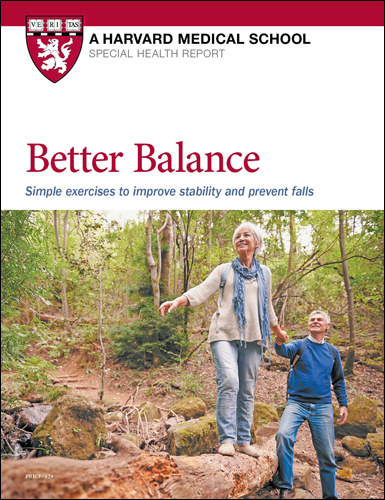
Counting steps is good — is combining steps and heart rate better?

Appendix pain: Could it be appendicitis?

Can saw palmetto treat an enlarged prostate?

How does Ozempic work? Understanding GLP-1s for diabetes, weight loss, and beyond

Zinc: What it does for the body, and the best food sources

Respiratory health harms often follow flooding: Taking these steps can help

Tips to leverage neuroplasticity to maintain cognitive fitness as you age

Can white noise really help you sleep better?

Celiac disease: Exploring four myths

What is prostatitis and how is it treated?


Gentle Core Exercises: Start toning your abs, building your back muscles, and reclaiming core fitness today
Gentle core exercises are specially designed for people who aren't up to tackling regular core exercises, perhaps because they are out of shape or possibly due to an injury or health problem. This Special Health Report, Gentle Core Exercises: Start toning your abs, building your back muscles, and reclaiming core fitness today, will show you how to build your core with workouts that are gentle and rewarding. You’ll be introduced to more than three dozen exercises designed to strengthen core muscles, increase flexibility and stability, improve balance, and tone your silhouette.
Other Product Information
In as little as fifteen minutes a day, you can build the core fitness that is essential for keeping you active and independent in the years ahead.
Weak or inflexible core muscles can impair how well your arms and legs function. A strong core makes everyday tasks less difficult, wards off back pain, and keeps you ready for your favorite sports and pastimes.
This Special Health Report will show you how to build your core with workouts that are gentle and rewarding. You’ll be introduced to more than three dozen exercises designed to strengthen core muscles, increase flexibility and stability, improve balance, and tone your silhouette.
Prepared by master trainers, Gentle Core Exercises will give you maximal gain in minimal time. Moreover, you’ll learn how to perform these exercises — stretches, lifts, planks, and more — safely and efficiently.
These are workouts that can be done anywhere and anytime. There’s no need for fancy clothes or pricey equipment (just a mat, a chair, and a ball). You can do the exercises at home or in your office. And our short workouts can be done in just 10 minutes for one set and 20 minutes for two.
And they can be done by anyone! These workouts work for people of all ages and fitness levels. They are designed for you to progress at your own pace and tailor the program to your own needs.
This Special Health Report was prepared by the editors of Harvard Health Publishing in consultation with Medical Editor Lauren E. Elson, MD, Physical Medicine and Rehabilitation Instructor at Harvard Medical School, as well as Michele Stanten, Certified Fitness Instructor at the American Council on Exercise. 49 pages. (2024)
A cure for “sitting disease”?
“Sitting disease” is a not-quite medical phrase that refers to the problems associated with sedentary habits. If exercise is linked to an ever-lengthening list of benefits, prolonged sitting — an apt description of work and home lives for many people — represents the flip side of the equation. A sedentary lifestyle is now associated with 34 chronic diseases or conditions — everything from heart disease, stroke, and type 2 diabetes to weight gain and cognitive decline. It may even increase your risk of premature death.
Why does prolonged sitting have such negative health consequences? The human body is designed for activity. When muscles are inactive, they don’t take up glucose from the bloodstream as efficiently. Blood pressure rises. Sleep suffers. There are even changes on the cellular level. Research has found that a key gene (which encodes for an enzyme called lipid phosphate phosphatase-1, or LPP1) helps prevent blood clotting and chronic, low-grade inflammation. This gene functions optimally when you engage in regular exercise.
Given such findings, breaking up long blocks of sitting to flex your muscles seems like a wise move for all of us. Take your phone calls standing up. Use a standing desk. Hold walking meetings. Sit on a stability ball to work or watch TV. Cut back on TV in favor of more brisk strolls or bike rides. Find excuses to run up and down the stairs more. And, yes, do core exercises.
- The importance of your core
- How a strong core benefits you
- Major core muscles
- Beyond muscles
- Beyond the core -- why exercise?
- Tailoring gentle core exercises to your abilities
- Should you check with your doctor first?
- How to adapt the routines
- 12 tips for doing gentle core work safely and effectively
- Structuring your workout: Four commonly asked questions
- How should core work fit into your overall exercise plans?
- What equipment will you need?
- What does the terminology in the instructions mean?
- How can you measure gains?
- Posture and alignment
- Posture checks
- Alignment: Stay neutral
- Choosing which gentle core exercises to do
- Two workouts and sets of stretches
- Two levels of difficulty
- Office Workout
- Office Stretch
- Home Workout
- Home Stretch
- SPECIAL SECTION: Setting goals and motivating yourself
- My monthly activity calendar
- Resources
- Glossary
You might also be interested in…

Better Balance: Simple exercises to improve stability and prevent falls
Discover how you can prevent falls by improving your balance and mobility. Better Balance: Simple exercises to improve stability and prevent falls gives you step-by-step instructions for easy, effective workouts that will improve posture, increase muscle strength and speed, sharpen reflexes, expand flexibility, and firm your core. You'll also get tips for fall-proofing your home.

Counting steps is good — is combining steps and heart rate better?

Appendix pain: Could it be appendicitis?

Can saw palmetto treat an enlarged prostate?

How does Ozempic work? Understanding GLP-1s for diabetes, weight loss, and beyond

Zinc: What it does for the body, and the best food sources

Respiratory health harms often follow flooding: Taking these steps can help

Tips to leverage neuroplasticity to maintain cognitive fitness as you age

Can white noise really help you sleep better?

Celiac disease: Exploring four myths

What is prostatitis and how is it treated?
Free Healthbeat Signup
Get the latest in health news delivered to your inbox!
Sign Up

